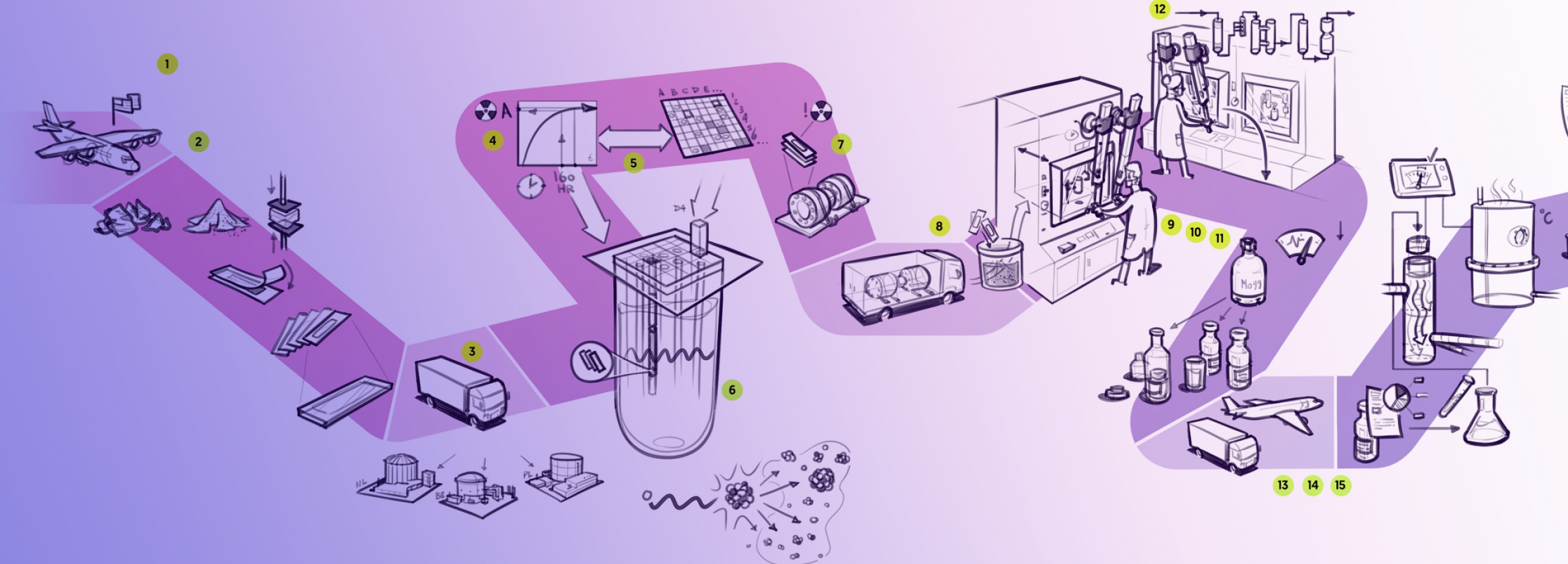Radiopharmaceuticals for nuclear medicine: a very careful process. We mapped out all the steps throughout the chain.
Nuclear tracers are needed for diagnoses and treatments of cancer, bone and brain disorders. This makes it possible to detect diseases at an early stage: with medical isotopes you can detect where (cancer) cells are accumulating. This allows a radiologist to see through a body without using a knife. In fact, one of the most beautiful things you can do with radioactive substances!

Goal: insight into the process creates understanding
Curium Pharma is one of the few producers of radioactive tracers in the world. Before these are delivered to a hospital, a intricate process is required. This is of course accompanied by extreme care. Fortunately, there are many checks and protocols, especially for transport. At the same time, time pressure is critical: it is essential that everything is delivered on time. The stakes are high!
For that reason, Curium wanted to be able to explain and show clearly how it all works. Because the process is not always transparant, and radiologists want to know why it sometimes takes longer before they receive a package on Monday. That is why we mapped out the entire chain – from raw material to usable product. To inform and above all to create understanding for this complex task.

Quality on time
A supply chain and value chain are two processes that are of great importance to a company. They ensure that good quality products are delivered to customers in a well-timed way. That is of course crucial with such a fragile and life-saving product!
This value chain shows all activities that generate or add value to the product. It actually gives a look behind the scenes of the making of a product, and enables users to see this from a different view.

How a drawing helps to structure thoughts
Flatland’s methodology challenges people to use their words very clearly. Professionals often suffer from ‘the curse of knowledge’: as soon as you know something (in this case everything about isotopes and nuclear chains), it is difficult to imagine that someone else does not have that knowledge. Drawing works as a mirror of your thoughts: a drawing will ask you questions. By seeing it, you can fill in the gaps in the drawing (sometimes literally an empty space on the whiteboard) and each other’s thoughts.
When visualizing you come across all kinds of things: are these parties on the same level? Is the order correct? Which information is more or less important? Or: where does the decay in radioactivity begin? You can add many layers of information.

Consistent and clear
We deliberately didn’t make the route a straight line, to emphasize that there are so many complex steps. By organizing the information differently, Curium recognized that they actually had a clear, consistent storyline. We also added a color coding: the production process in pink, the logistics in purple. And it turned out to be important to provide insight into where all the risks are located, so we have added the critical path separately at the bottom – in green.

Result: discovering the magic of a special product
The visualization of the value chain has been received with a lot of enthusiasm. Curium was now able to show what they all do, and make clear what the value of the company actually is. They could now start selling themselves, instead of the end product. This is important for external use, to provide insight for customers and for gaining understanding. But it also helps the colleagues within the company with something powerful: a consistent storyline and a clear message.

Understanding complex matter makes Flatland stand out
Flatland’s Robert Smit is proud: “This is a perfect example of what we can do, and it shows that Flatland does more than make beautiful pictures. Because in order to visualize something like this, you really have to understand it well and think along at a high level.”
Thomas van Daalen
Also working on work processes and chain collaborations? Send us an email!
Email Thomas
Other Flatland Cases

ProRail - Environment, assets and importance clarified
For this complex operational organization, we clarified all activities, environments and assets. Drawings put departments on the map!

C-ARM - Clarifying change processes
With visual storytelling you tell a story. To explain and clarify a new program and get everyone involved!

Groot Saeftinghe - Unique borderland envisioned
Groot Saeftinghe is experimenting with measures to stimulate biodiversity. To enthuse farmers and policy makers, we made a visual and interactive plan.

